Research on Mechanical Performance of Porous Asphalt Mixture with High-Viscosity Modified Asphalt
Abstract
1. Introduction
2. Preparation and Performance Analysis of High-Viscoelastic Modified Asphalt
2.1. Raw Materials
- (1)
- Thermoplastic materials
- (2)
- Resin
- (3)
- Antioxidant
- (4)
- Stabilizer
- (5)
- Co-solvent
2.2. Preparation Process of High-Viscosity Modifier
- (1)
- Shear all raw materials at high speed for 10 min, then transfer them to a high-temperature mixer and mix for 10 min.
- (2)
- Transfer the mixed materials to a twin-screw extruder for extrusion.
- (3)
- Place the molded material in 5 °C pure water to cool for 20 min.
- (4)
- Place the cooled material in a shearing device to shear it into granular high-viscoelastic modifiers A and B.
2.3. Preparation Process of High-Viscoelastic Modified Asphalt
- (1)
- Heat the SBS-modified bitumen in an oven at 175 °C until it melts.
- (2)
- Heat the asphalt to 170–180 °C, add the high-viscoelastic modifier and co-solvent separately, and activate the high-speed shear for dispersion. The shear time is 45 min at a rotational speed of 4000 rad/min.
- (3)
- After shearing, add the stabilizer and stir at 180 °C for 30 min to obtain the high-viscoelastic modified bitumen.
2.4. Determination of Optimum Content of High-Viscoelastic Modifier in Asphalt
2.4.1. Penetration Test and Analysis of Results
2.4.2. Ductility Test and Result Analysis
2.4.3. Softening Point Test and Analysis
2.4.4. 60 °C Dynamic Viscosity
2.5. Research on the Optimum Type of High-Viscosity Modifier
3. Research on Mechanical Performance of Porous Asphalt Mixture
3.1. Raw Material and Mixture Design
3.1.1. Raw Material
- (1)
- Asphalt
- (2)
- Aggregate
- (3)
- Filler
3.1.2. Porous Asphalt Mixture Design
3.2. Research on Mechanical Performance of High-Viscosity Modified Asphalt Mixtures
3.2.1. High Temperature Stability
- (1)
- Specimen Formation: The specimen size is 300 mm × 300 mm × 50 mm, prepared using an indoor rutting tester. The test begins 48 h after the specimen is formed and left to stand.
- (2)
- Test Process: Before starting the test, the specimen should be placed in a 60 °C heat preservation box for 6 h. Then, a small rutting test machine should be used to perform the rutting and crushing test. The test temperature is 60 °C, the rubber wheel crushing pressure is 0.7 MPa, the crushing speed is 42 times per minute, and the crushing time is 1 h.
- (3)
- Data Collection: The rut depth and dynamic stability indices are obtained from the deformation depth versus time curve at the end of the wheel rolling.
3.2.2. Low Temperature Cracking Resistance
3.2.3. Water Stability
3.2.4. Fatigue Resistance
4. Research on Skid Resistance of Porous Asphalt Mixtures
4.1. Anti-Skid Performance Test and Evaluation Method
- (1)
- Friction Coefficient Measurement Method
- (2)
- Dynamic Friction Coefficient Measurement
- (3)
- Indoor accelerated wear test
4.2. Research on the Slip Degradation Law of High-Viscosity Porous Asphalt Mixture Based on Indoor Accelerated Wear Tests
4.2.1. Research on the Initial Value of Slip Resistance
- (1)
- Friction coefficient of pendulum value
- (2)
- Dynamic friction coefficient
4.2.2. Research on Skidding Decay Pattern of Porous Asphalt Mixtures
5. Conclusions
- (1)
- The novel preparation protocol enables precise control over viscoelastic balance, with modifier content demonstrating a critical threshold effect. At 9% dosage, the modified asphalt achieves optimal engineering performance, showing 16.6% and 9.3% simultaneous improvement in high-/low-temperature indices compared to 10-B asphalt mixture.
- (2)
- The redesigned modifier architecture enhances rutting resistance and water stability through strategic antioxidant–resin ratio optimization. This breakthrough resolves the traditional trade-off between fatigue resistance and thermal stability.
- (3)
- Friction dynamics analysis reveals that the PA-10 mixture’s unique stabilizer-antioxidant synergy enables speed-adaptive friction characteristics, maintaining BPN > 85 even after 8 h abrasion cycles. This provides a theoretical foundation for smart pavement design in extreme climates.
Author Contributions
Funding
Institutional Review Board Statement
Informed Consent Statement
Data Availability Statement
Acknowledgments
Conflicts of Interest
References
- Chen, W.; Wei, K.S.; Wei, J.C.; Han, W.Y.; Zhang, X.M.; Hu, G.L.; Wei, S.S.; Niu, L.; Chen, K.; Fu, Z.; et al. Research on the Road Performance of Asphalt Mixtures Based on Infrared Thermography. Materials 2022, 15, 4309. [Google Scholar] [CrossRef]
- Liu, S.J.; You, Q.L. Mechanical Response of Asphalt Pavement under Overloading. Appl. Mech. Mater. 2013, 361–363, 1869–1872. [Google Scholar] [CrossRef]
- Qin, C.L.; Liu, C.Q. Analysis of Characters of Traffic Accidents Based on Road Factors. Technol. Econ. Areas Commun. 2010, 12, 14–17. [Google Scholar]
- Izuo, H.; Nabeshima, M.; Yasuhisa, K.; Kishira, R.; Ueno, A. Evaluation Method of Road Surface Texture Related to Skid Resistance of Concrete Pavement. J. Jpn. Soc. Civ. Eng. Ser. E1 (Pavement Eng.) 2021, 77, I_145–I_153. [Google Scholar] [CrossRef] [PubMed]
- Jun, L.; Ge, W.; Mingliang, L.; Yue, Z.; Shi, F.; Dingding, H. Mixture Performance Analysis and Engineering Application of High Strength and Toughness Wearing Course STC-8. In Proceedings of the 13th International Conference on Road and Airfield Pavement Technology (ICPT), Beijing, China, 6–8 July 2023; pp. 429–438. [Google Scholar]
- Li, W.B.; Zheng, M.L.; Ning, Z.; Zhang, W.W.; Ding, X.Y. The design and performance evaluation of low-noise rubber-fibre micro-surfacing pavement. Int. J. Pavement Eng. 2024, 25, 2414056. [Google Scholar] [CrossRef]
- Chang, J.; Li, J.; Yang, H.; Wang, Y.D.; Hu, H.W. Optimizing epoxy asphalt tack coat formulations for improved adhesion and working performance of ultrathin wearing course. J. Adhes. Sci. Technol. 2024, 1–26. [Google Scholar] [CrossRef]
- Ziaei-Rad, V.; Nouri, N.; Ziaei-Rad, S.; Abtahi, M. A numerical study on mechanical performance of asphalt mixture using a meso-scale finite element model. Finite Elem. Anal. Des. 2012, 57, 81–91. [Google Scholar] [CrossRef]
- Geng, J.G.; Chang, Q.; Yuan, J.A.; Dai, J.L. Study on SBS Modified Asphalt Crosslink Structure and Its Stabilization by GPC. J. Zhengzhou Univ. (Eng. Sci.) 2008, 29, 14–17. [Google Scholar]
- Shi, C.; Wu, Y.; Wang, T.; Yu, Y.; Wang, H.; Yang, J. Rheological properties and polymer phase structure characterization of SBS/CR composite modified asphalt (CMA) binders. Mater. Struct. 2023, 56, 33. [Google Scholar] [CrossRef]
- De Maio, U.; Gaetano, D.; Greco, F.; Luciano, R.; Pranno, A. Degradation analysis of dynamic properties for plain concrete structures under mixed-mode fracture conditions via an improved cohesive crack approach. Fract. Struct. Integr. 2024, 18, 422–439. [Google Scholar] [CrossRef]
- Yao, H.; Wang, T.; Wang, Q.; Cao, Y.; Zhou, X. Applicability of Standard Rheological Evaluation Methods for High Content SBS Polymer Modified Asphalts. Buildings 2023, 13, 1156. [Google Scholar] [CrossRef]
- Kandhal, P. New generation open-graded asphalt friction courses. Public Work 2001, 132, 18–21. [Google Scholar]
- Molenaar, J.M.M.; Hagos, E.T.; Ven De Ven, M.F.C. An Investigation into the Specification of Rheological Properties of Polymer Modified Bitumen. In Proceedings of the 3rd Eurasphalt and Eurobitume Congress, Vienna, Austria, 12–14 May 2004. [Google Scholar]
- Kmetz, M.; Timm, D.; Rodezno, C.; Tran, N.; Yin, F. Laboratory Characterization of Additive-Modified Asphalt Concrete Mixtures. Transp. Res. Rec. 2024, 2678, 1119–1130. [Google Scholar]
- Vinogradov, G.V.; Dreval, V.E.; Malkin, A.Y.; Yanovsky, Y.G.; Barancheeva, V.V.; Borisenkova, E.K.; Zabugina, M.P.; Plotnikova, E.P.; Sabsai, O.Y. Viscoelastic properties of butadiene-styrene block copolymers. Rheol. Acta 1978, 17, 258–263. [Google Scholar]
- Du, M.A.; Yu, Q.M.; Lu, Y.; Zheng, Q.A. Viscoelastic Relaxation of Styrene-Butadiene-Styrene Block Copolymers with Different Topological Structures. J. Appl. Polym. Sci. 2011, 120, 2962–2970. [Google Scholar] [CrossRef]
- Li, K.; Ma, H.; Xie, J.; Li, S.; Pan, Y.; Zhang, Z.; Guan, Y. Compatibility Assessment of High-viscosity Additive and SBS-modified Asphalt. J. Phys. Conf. Ser. 2024, 2920, 012004. [Google Scholar]
- Islam, S.S.; Singh, S.K.; Ransinchung R.N., G.D.; Ravindranath, S.S. Performance Degradation during Elevated Storage Temperature of SBS-Modified Binders and Asphalt Mixes: Impact of SBS Molecular Structure. J. Mater. Civ. Eng. 2023, 35, 04022457. [Google Scholar]
- Zhang, F.; Hu, C. The research for thermal behaviour, creep properties and morphology of SBS-modified asphalt. J. Therm. Anal. Calorim. 2015, 121, 651–661. [Google Scholar]
- Dong, F.; Lu, J.; Yu, X.; Yang, P.; Jin, Y.; Wan, L.; Ding, Y.; Chen, H. Insight into the diffusion behaviors of SBS-compatibilizer-coupled modified asphalt: Molecular dynamics simulation and experimental validation. J. Vinyl Addit. Technol. 2024, 30, 15. [Google Scholar]
- Xu, B.; Chen, J.; Li, M.; Cao, D.; Ping, S.; Zhang, Y.; Wang, W. Experimental investigation of preventive maintenance materials of porous asphalt mixture based on high viscosity modified bitumen. Constr. Build. Mater. 2016, 124, 681–689. [Google Scholar]
- Bulatovic, V.O.; Rek, V.; Markovic, K.J. Effect of polymer modifiers on the properties of bitumen. J. Elastomers Plast. 2014, 46, 448–469. [Google Scholar] [CrossRef]
- Zhong, K.; Cao, D.W.; Luo, S. Determination the Modifier Content in SBS Modified Asphalt Based on Infrared Spectroscopy Technique. Appl. Mech. Mater. 2010, 34–35, 1129–1134. [Google Scholar]
- Sukhanov, A.S.; Kolosov, A.D.; Kondrat’Ev, V.V.; Kononenko, R.V. Technology for the production of modifying additives for concrete and asphalt concrete. IOP Conf. Ser. Mater. Sci. Eng. 2021, 1159, 012047. [Google Scholar]
- Baghaee Moghaddam, T.; Soltani, M.; Karim, M.R.; Baaj, H. Optimization of asphalt and modifier contents for polyethylene terephthalate modified asphalt mixtures using response surface methodology. Measurement 2015, 74, 159–169. [Google Scholar]
- Wang, Y.L.; Yi, H.Y.; Cui, Y.; Li, S.J.; Zhou, S.X.; Yan, C.Q. Research on the Preparation Process of SBS-Modified Asphalt Using Early Shearing Instead of High-Speed Shearing of Modifier. Appl. Sci. 2023, 13, 10335. [Google Scholar] [CrossRef]
- Izumoto, R. Asphalt Modifier, and Method of Producing Modified Asphalt and Paving Material. U.S. Patent Application No. 09/888,409, 15 August 2002. [Google Scholar]
- Zhi-Lin, S.; Xiao-Ming, H.; Rui, Z.; Yan, W. Study on Effect of Asphalt Modifier on Asphalt Mixtures Fatigue Performance. J. Highw. Transp. Res. Dev. 2008, 4, 33–36. [Google Scholar]
- Gorbaty, M.L.; Peiffer, D.G.; Mchugh, D.J. Polymer-Modified, Functionalized Asphalt Compositions and Methods of Preparation (C-2747). U.S. Patent 5,348,994, 5 March 2012. [Google Scholar]
- Weiyu, F.; Xue, X.; Ming, L.; Yan, Y.; Fuqiang, D.; Guozhi, N. Comparative study on the rheological properties and storage stability of modified bitumen prepared by different modifiers. Zhongguo Shiyou Daxue Xuebao (Ziran Kexue Ban)/J. China Univ. Pet. (Ed. Nat. Sci.) 2015, 39, 165–170. [Google Scholar]
- Zhao, P.; Song, X.; Dong, M.; Sun, H.; Wu, W.; Zhang, R.; Sun, M.; Zhao, X. Preparation and characterization of CQDs/SBS composites and its application performance as asphalt modifier. Constr. Build. Mater. 2022, 320, 126312. [Google Scholar]
- Ahmed, M.B.; Abed, A.H.; Al-Badran, Y.M.H. Enhancement of porous asphalt mixture for resisting environmental conditions using modified asphalt. IOP Conf. Ser. Mater. Sci. Eng. 2020, 737, 012118. [Google Scholar]
- Hao, P.W. Study on compatibility between SBS modifier and asphalt. Pet Process Petrochem 2001, 32, 54–56. [Google Scholar]
- Yu, X. Reasonable Dosage of Modifiers for Modified Asphalt Pavement of Ji-Mu Freeway. J. Northeast For. Univ. 2006, 34, 118–119. [Google Scholar]
- Sun, D.Q.; Lu, W.M. Evaluation of low temperature performances of polymer modified asphalts by force-ductility test. J. Build. Mater. 2007, 10, 37–42. [Google Scholar]
- Algurah, E.R.; Alghurabi, S.J.; Alhumeidawi, B.H. Laboratory evaluation of properties of modified asphalt binder with different types of additives. IOP Conf. Ser. Earth Environ. Sci. 2023, 1232, 012043. [Google Scholar] [CrossRef]
- Babagoli, R.; Jalali, F.; Khabooshani, M. Performance properties of WMA modified binders and asphalt mixtures containing PPA/SBR polymer blends. J. Thermoplast. Compos. Mater. 2023, 36, 274–306. [Google Scholar] [CrossRef]
- Bahia, H.U.; Anderson, D.A. The Development of the Bending Beam Rheometer; Basics and Critical Evaluation of the Rheometer. In Physical Properties of Asphalt Cement Binders; ASTM International: West Conshohocken, PA, USA, 1995. [Google Scholar]
- Guo, Y.; Ji, G.; Wang, X.; Tian, B.; Zhang, Y. Physico-chemical and mechanical properties of asphalt binders blended with waste bio-shell powder. Int. J. Pavement Eng. 2023, 24, 2211213. [Google Scholar] [CrossRef]
- Aurilio, M.; Tavassoti, P.; Elwardany, M. Characterization of styrene-butadiene-styrene (SBS)-modified asphalt binders using the bending beam rheometer and the asphalt binder cracking device. Can. J. Civ. Eng. 2023, 50, 681–687. [Google Scholar] [CrossRef]
- Syukri, M.; Juandana, H.; Kusdian, D.; Garnida, H.; Pratiwi, A.A.R. Analysis of Pavement Conditions and Handling of Road Damage at the Surface Layer. IOP Conf. Ser. Earth Environ. Sci. 2024, 1321, 012032. [Google Scholar] [CrossRef]
- Praveen, K.P.; Kiran, K.B.V.; Manjunatha, S.G.P.B. An Experimental Investigation on the Rutting Performance of the Polymer Modified Bituminous (PMB) Mixes. Civ. Eng. Archit. 2024, 12, 1260–1268. [Google Scholar]
- Wu, B.; Luo, C.; Pei, Z.; Xia, J.; Kang, A. Effect of Different Polymer Modifiers on the Long-Term Rutting and Cracking Resistance of Asphalt Mixtures. Materials 2021, 14, 3359. [Google Scholar] [CrossRef]
- Zhuang, C.; Li, N.; Zhao, W.; Cai, C. Effects of SBS Content on the Performance of Modified Asphalt. IOP Conf. Ser. Mater. Sci. Eng. 2017, 216, 012028. [Google Scholar] [CrossRef]
- Chen, H.X.; Zhang, H.L.; Jiang, Y.; Li, S. Low-temperature properties of aged asphalt mixtures. J. Chang. Univ. (Nat. Sci. Ed.) 2010, 30, 1–5. [Google Scholar]
- Singhvi, P.; Karakas, A.; Ozer, H.; Al-Qadi, I.L.; Hossain, K. Impact of Asphalt Modifier Dosage on Modified Binder Rheology and Chemistry with Long-Term Aging. In Proceedings of the International Airfield and Highway Pavements Conference 2019, Chicago, IL, USA, 21–24 July 2019. [Google Scholar]
- Sun, Z.H.; Yang, G.F.; Wang, T.B.; Wang, Z.S. Research on Evaluation Index of Water Stability for Asphalt Mixtures. Adv. Mater. Res. 2013, 634–638, 2724–2728. [Google Scholar]
- Manoj, K.G. System Identification Framework for Modeling of Static Creep and Dynamic Creep Behavior of Dense-Graded Asphalt Mixtures. Transp. Res. Rec. 2024, 2678, 776–789. [Google Scholar] [CrossRef]
- Ren, S.S.; Liu, X.Y.; Jing, R.X.; Gao, Y.M.; Lin, P.; Erkens, S. Investigating the rheological properties and compatibility behaviours of RET/PE and WR/CR/SBS compound-modified bitumen. Road Mater. Pavement Des. 2024, 25, 653–677. [Google Scholar] [CrossRef]
- Meng, G.; Yiqiu, T. Effects of Various Modifiers on Rheological Property of Asphalt. In Multi-Scale Modeling and Characterization of Infrastructure Materials: Proceedings of the International RILEM Symposium, Stockholm, Sweden, 10–12 June 2013; Springer: Dordrecht, The Netherlands, 2013. [Google Scholar]
- Yazdipanah, F.; Ameri, M.; Shahri, M.; Hasheminejad, N.; Haghshenas, H. Laboratory investigation and statistical analysis of the rutting and fatigue resistance of asphalt mixtures containing crumb-rubber and wax-based warm mix asphalt additive. Constr. Build. Mater. 2021, 309, 125165. [Google Scholar]
- Nuñez, J.Y.M.; Leonel, E.D.; Faxina, A.L. Fatigue characteristics of modified asphalt binders using fracture mechanics. Eng. Fract. Mech. 2016, 154, 1–11. [Google Scholar]
- Tafti, M.F.; Aqda, S.A.H.; Motamedi, H. The impacts of type and proportion of five different asphalt modifiers on the low-temperature fracture toughness and fracture energy of modified HMA. Fract. Struct. Integr. 2019, 13, 169–185. [Google Scholar] [CrossRef]
- Pilati, F.; Furlan, A.P.; Faxina, A.; Fabbri, G.; Sória, M.; Gigante, A. Effects of Some Modifiers on Moisture Susceptibility of Dense Graded Asphalt Mixtures. In Proceedings of the Sixth International Conference on Maintenance and Rehabilitation of Pavements and Technological Control (MAIREPAV6), Turin, Italy, 8–10 July 2009. [Google Scholar]
- Xiao-Ming, H.; Bin-Shuang, Z.; Transportation, S.O.; University, S. Research Status and Progress for Skid Resistance Performance of Asphalt Pavements. China J. Highw. Transp. 2019, 4, 32–49. [Google Scholar]
- Croney, D.; Croney, P. The Design and Performance of Road Pavements; McGraw-Hill: New York, NY, USA, 1977. [Google Scholar]
- Schmitz, T.L.; Action, J.E.; Ziegert, J.C.; Sawyer, W.G. Dynamic Friction Coefficient Measurements: Device and Uncertainty Analysis. In Proceedings of the 18th American Society of Precision Engineers, Annual Meeting, Portland, OR, USA, 26–31 October 2003. [Google Scholar]
- Liu, J.; Guan, B.; Chen, H.; Liu, K.; Xiong, R.; Xie, C. Dynamic Model of Polished Stone Value Attenuation in Coarse Aggregate. Materials 2020, 13, 1875. [Google Scholar] [CrossRef]
- Gong, Y.; Pang, Y.; Li, F.; Ma, Y. Analysis of the Influence of SBS Content and Structure on the Performance of SBS/CR Composite Modified Asphalt. Adv. Mater. Sci. Eng. 2021, 2021, 5585891. [Google Scholar]
- Zhu, S.; Ji, X.; Zhang, Z.; Shao, D.; Li, H.; Yun, C. Evolution characteristics of the surface texture of the wearing course on asphalt pavement based on accelerated pavement polishing. Constr. Build. Mater. 2022, 333, 127266. [Google Scholar] [CrossRef]
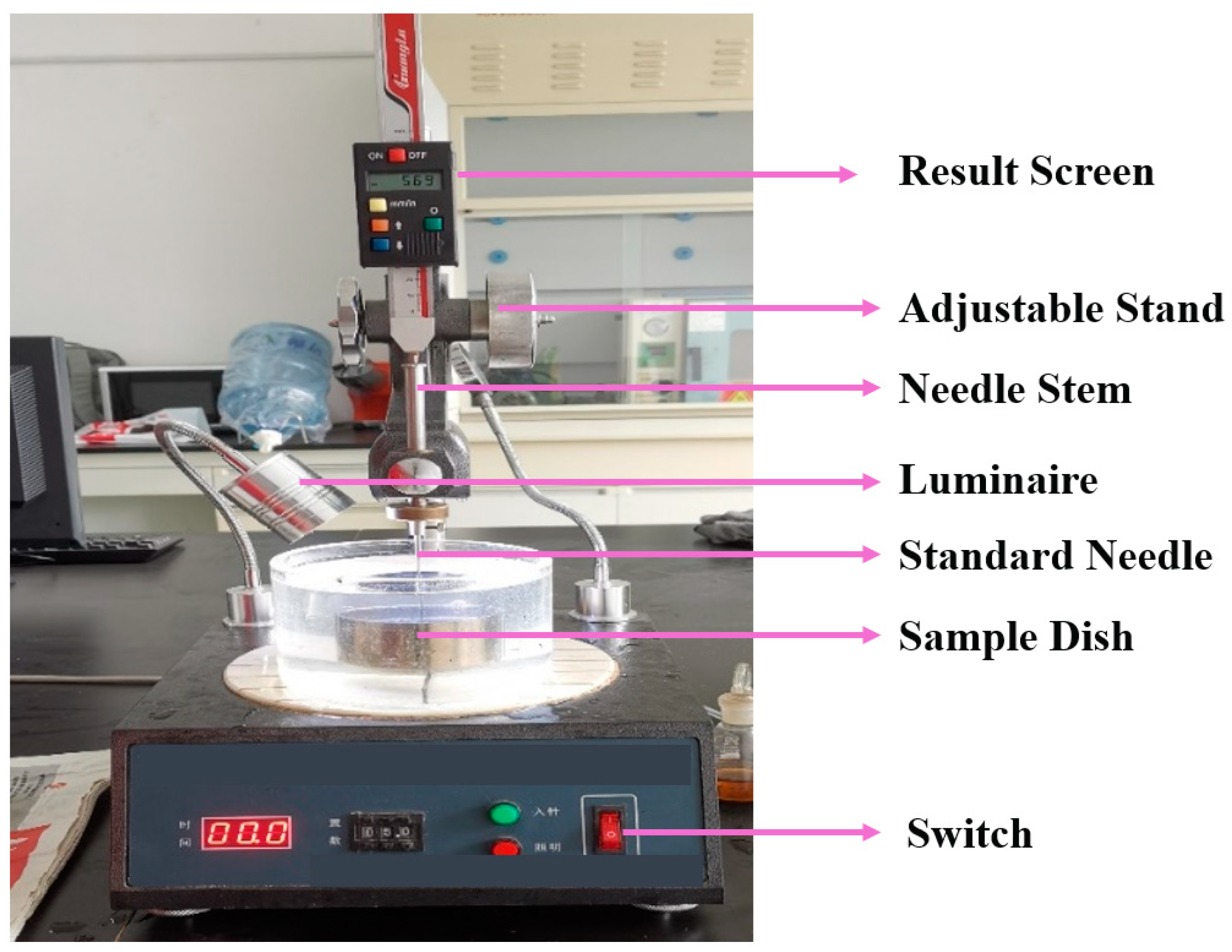


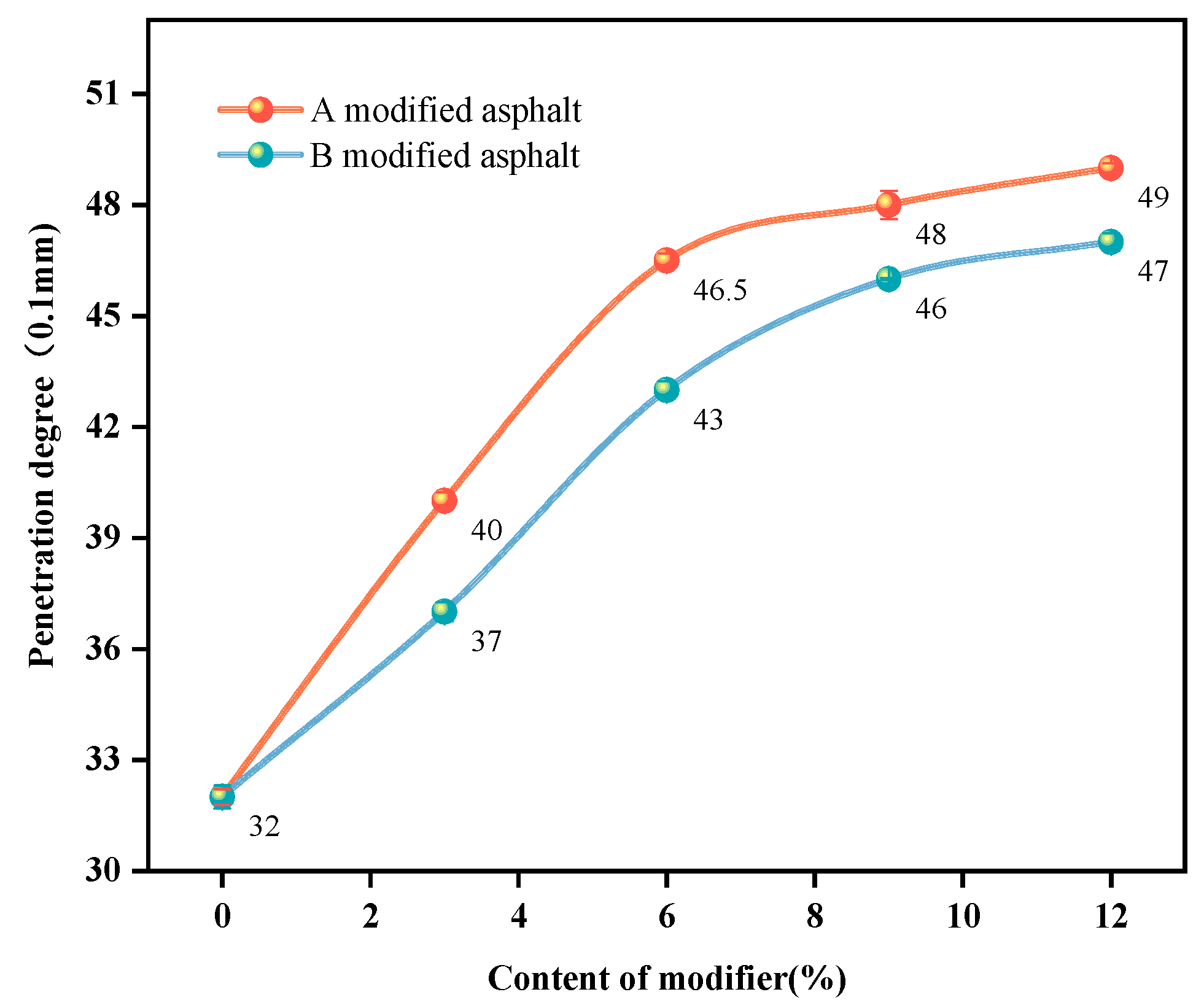
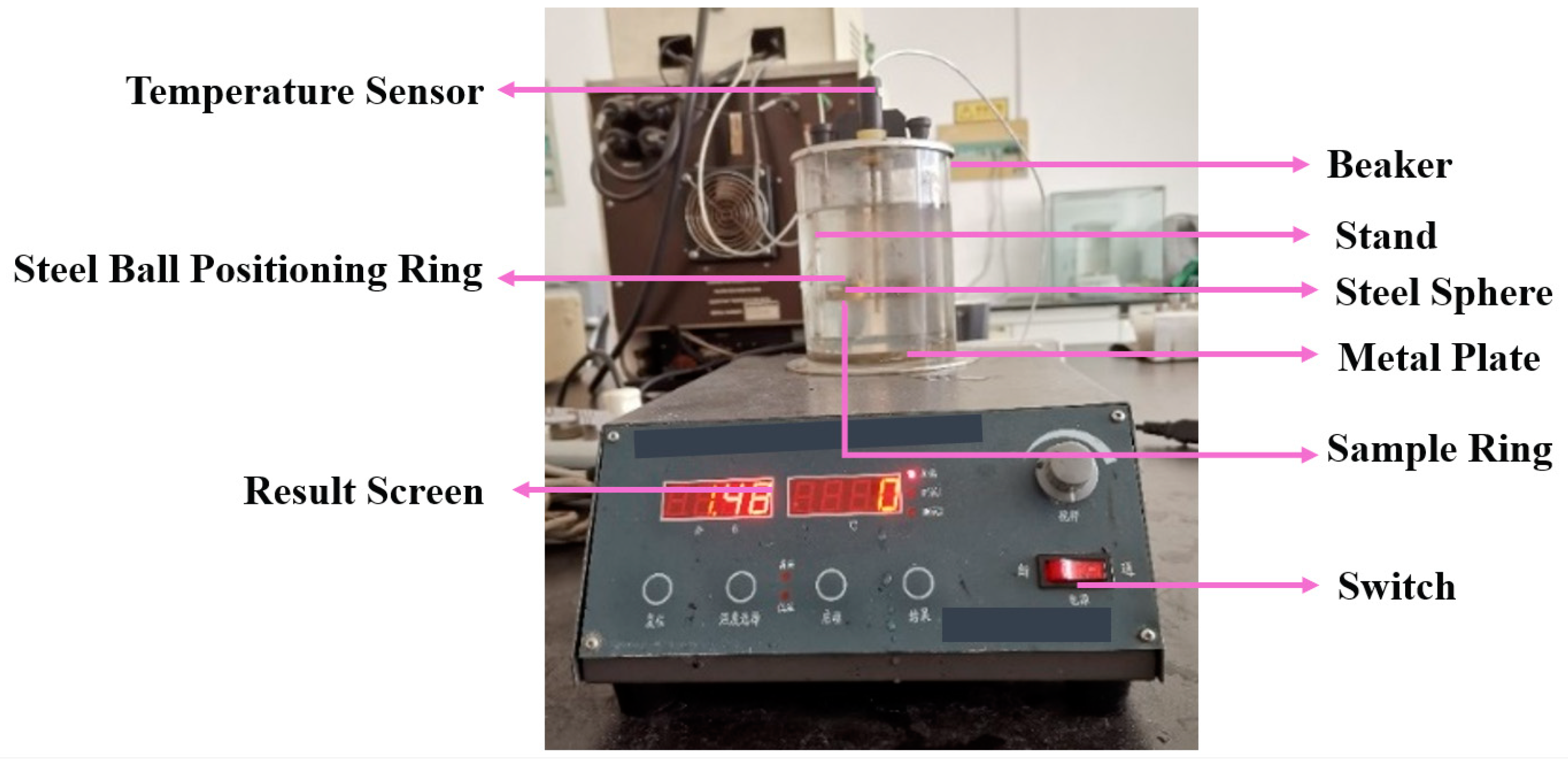
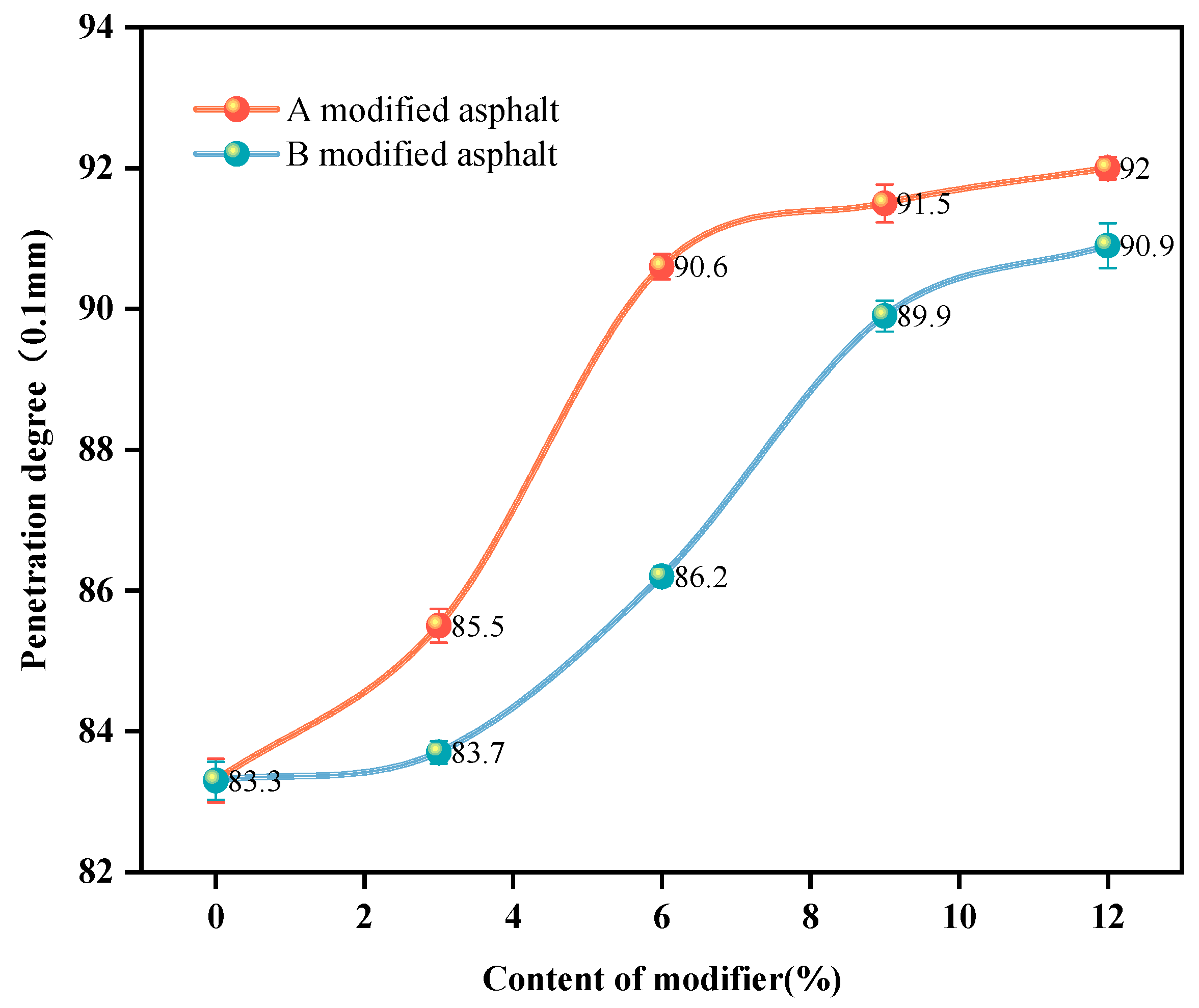
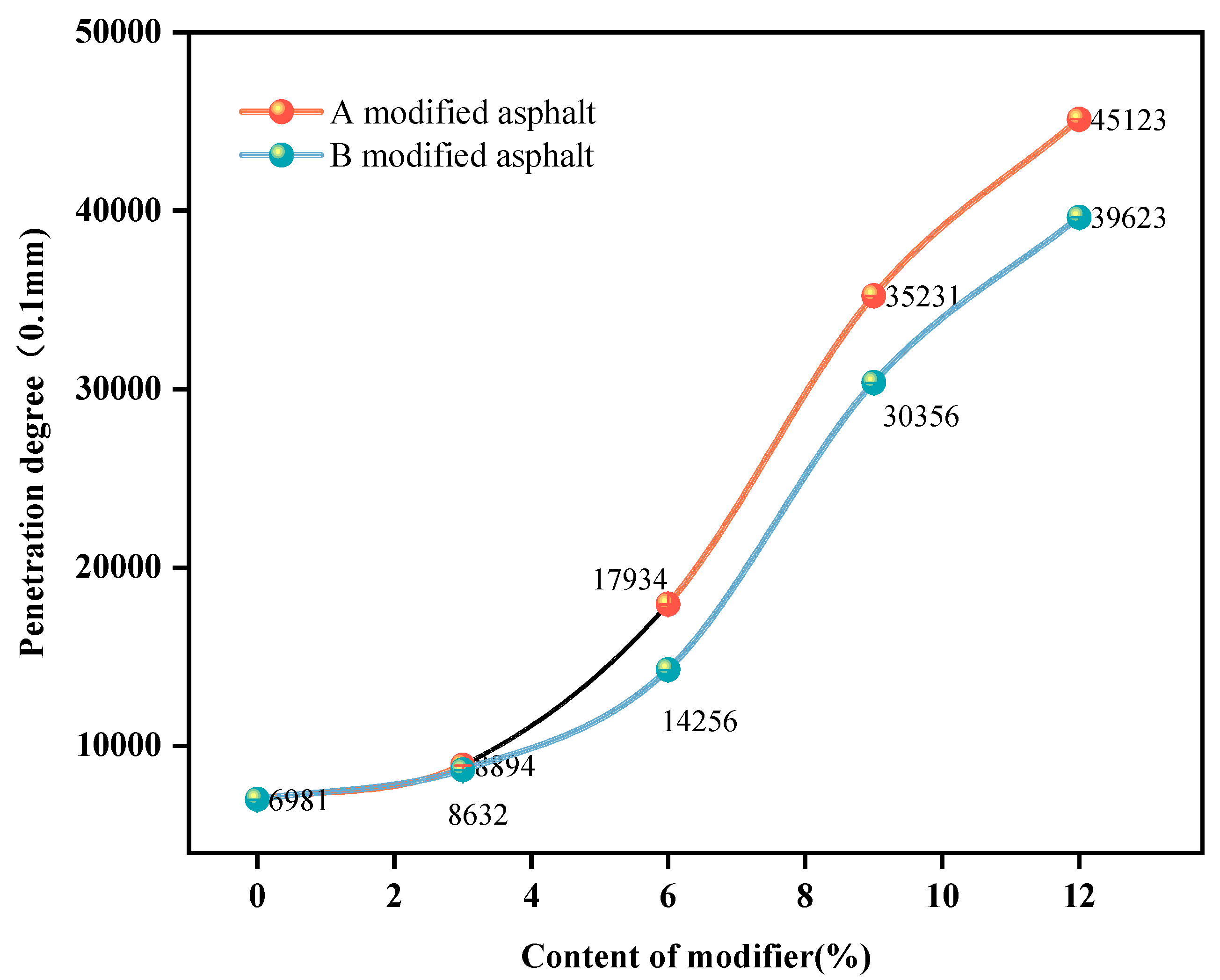
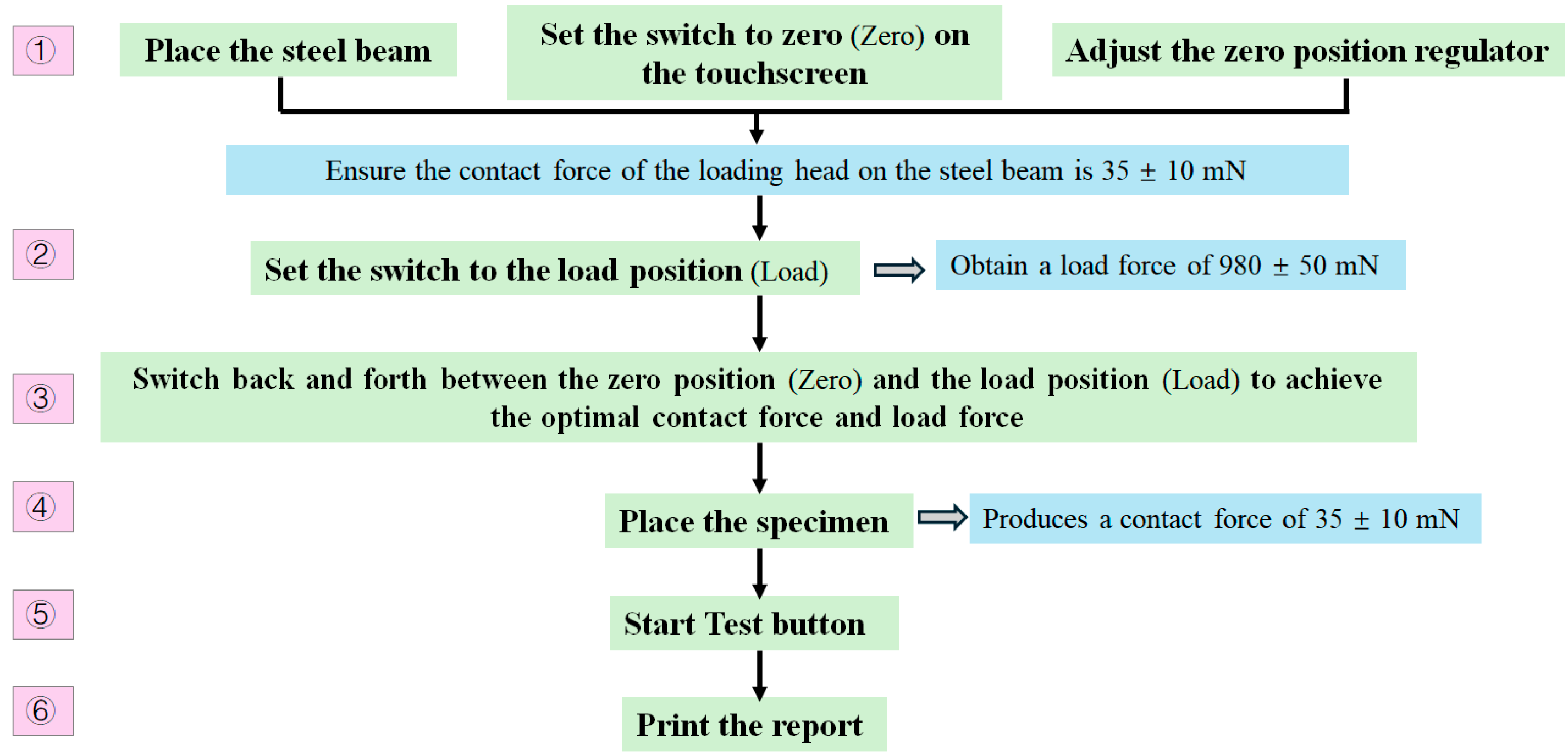

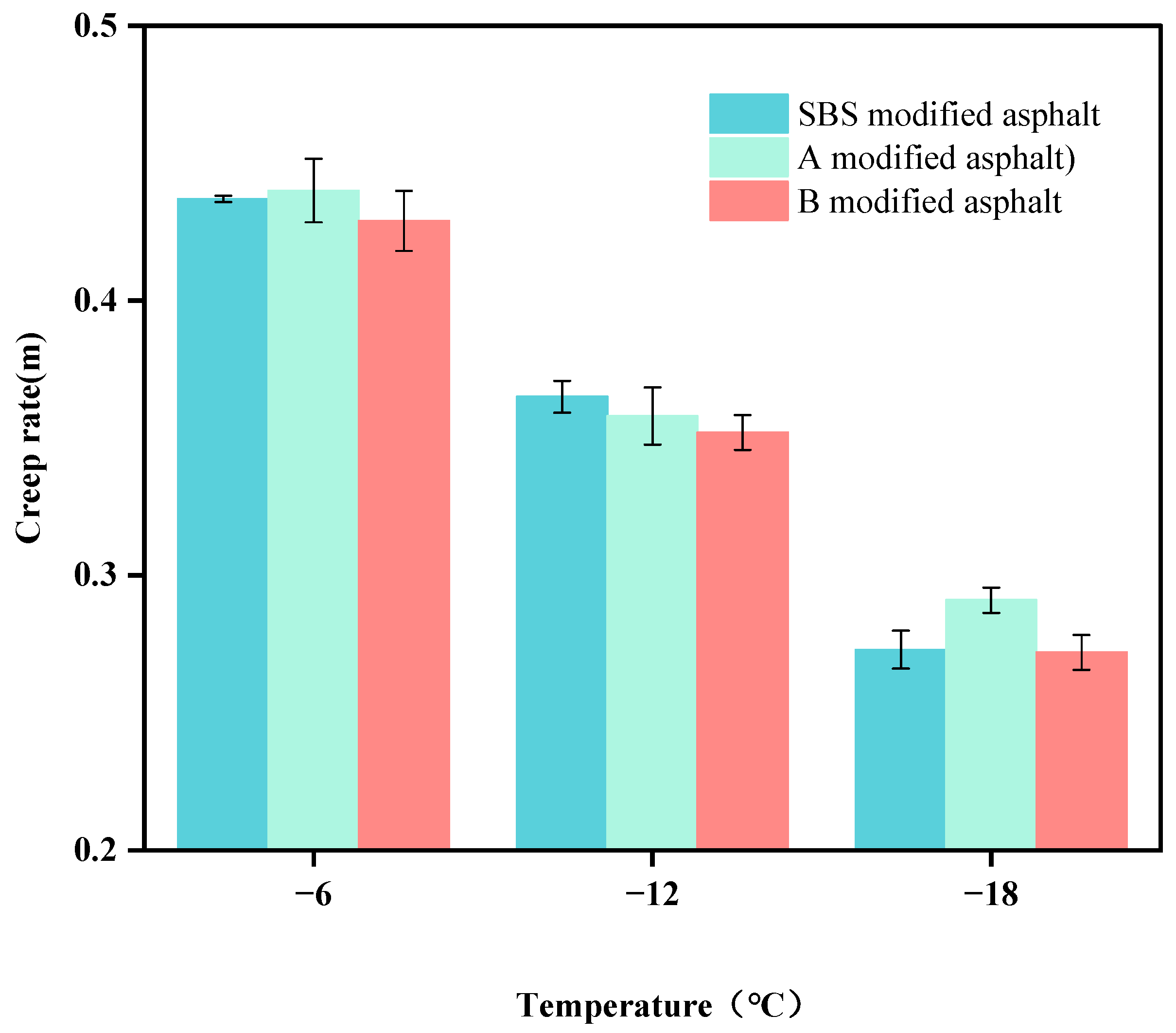

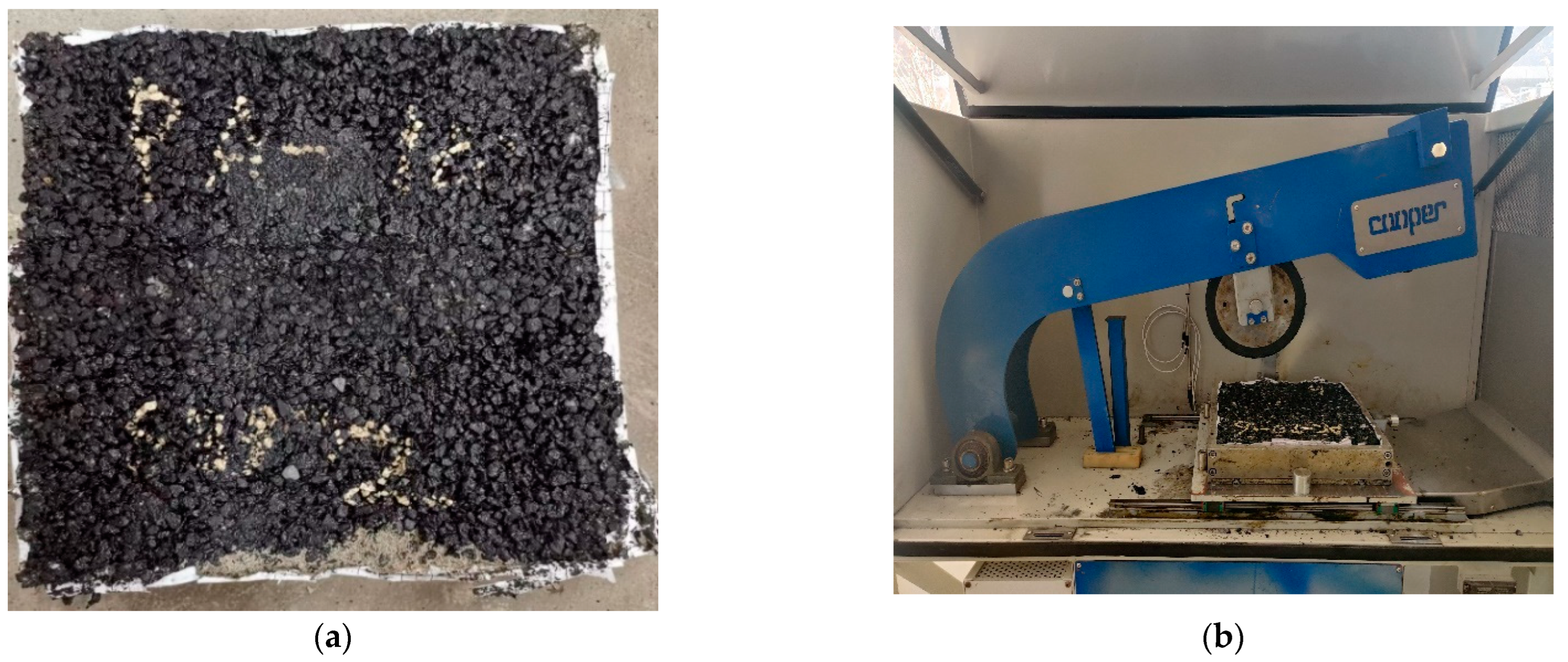
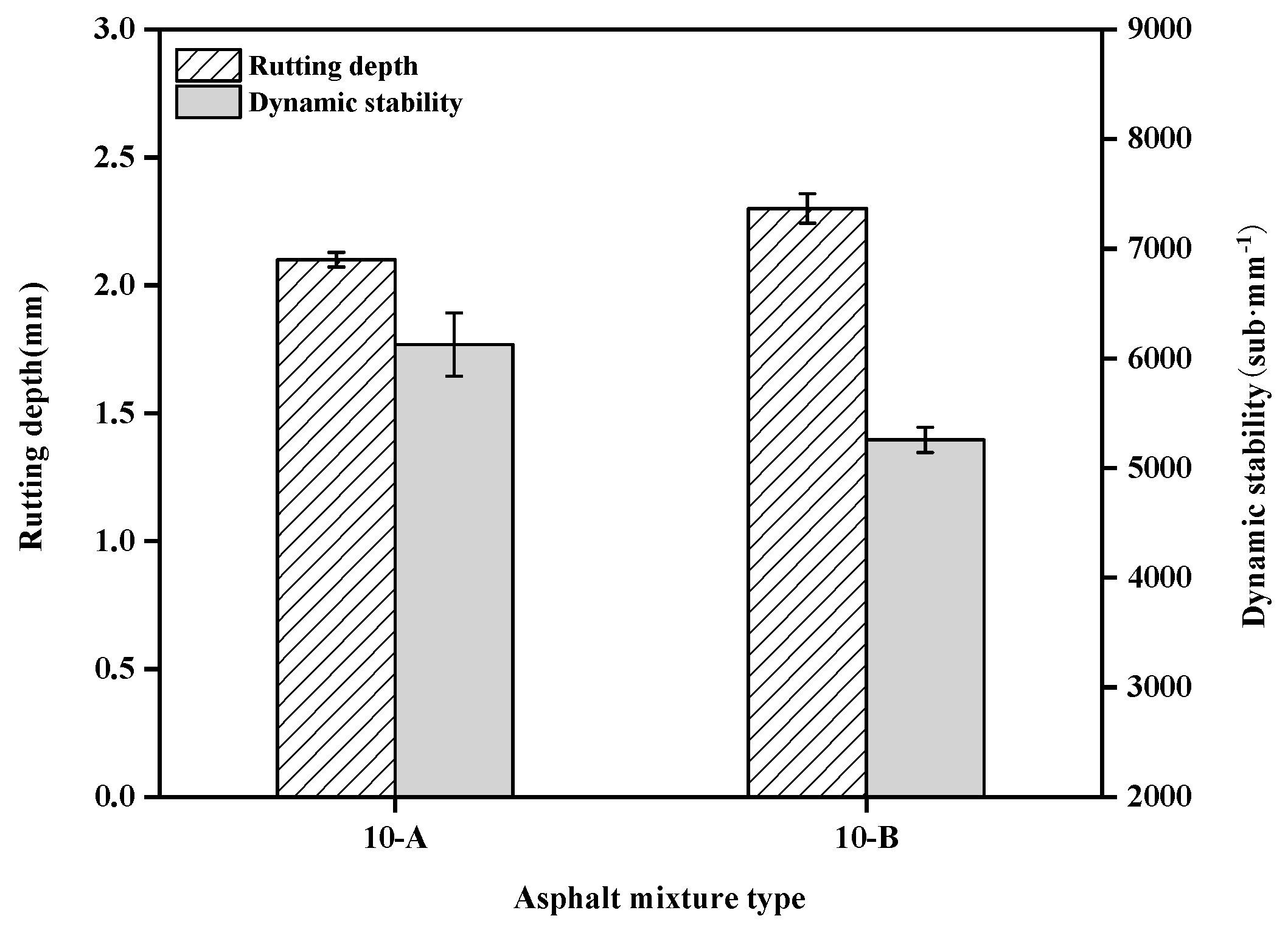
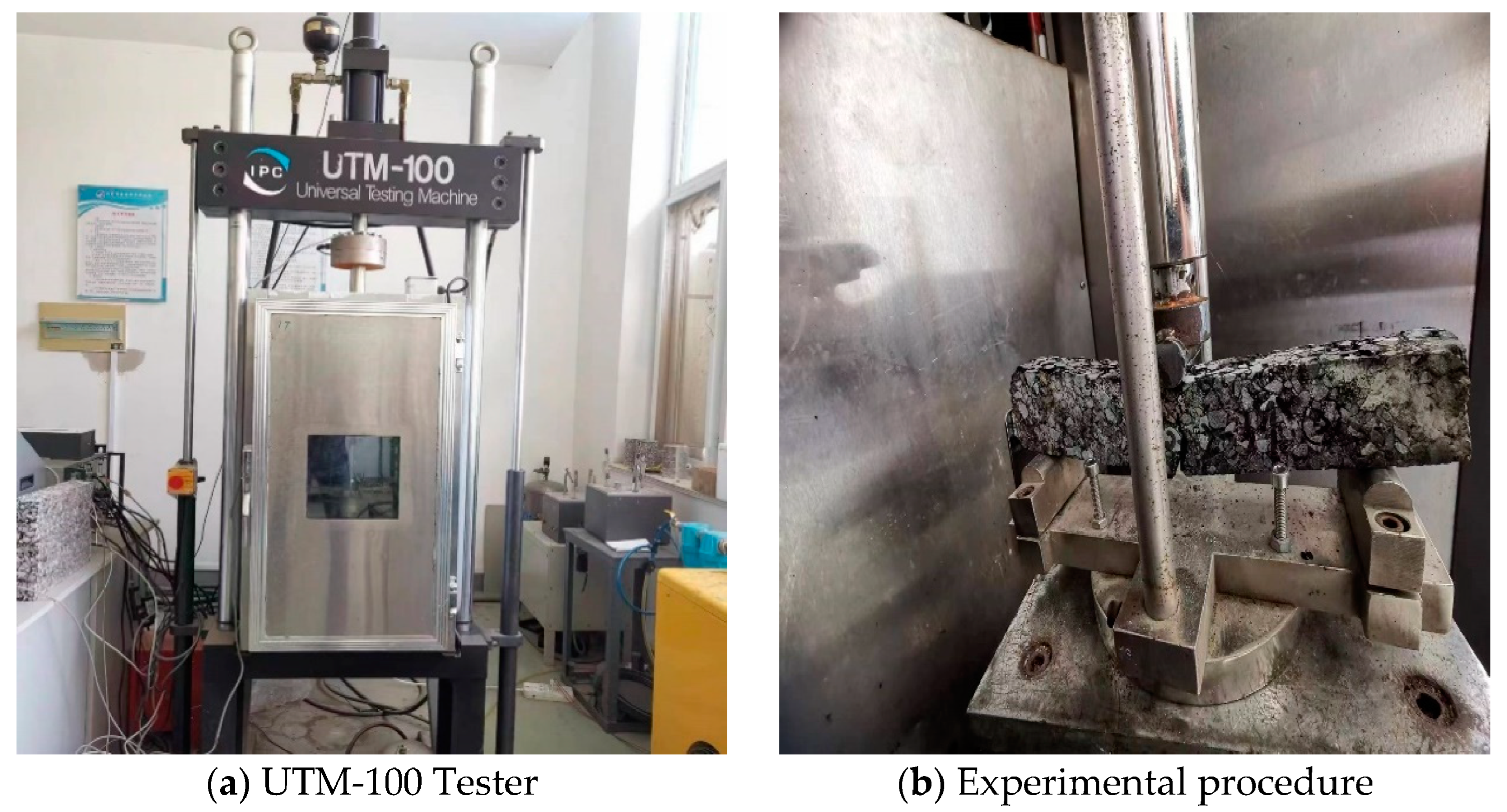



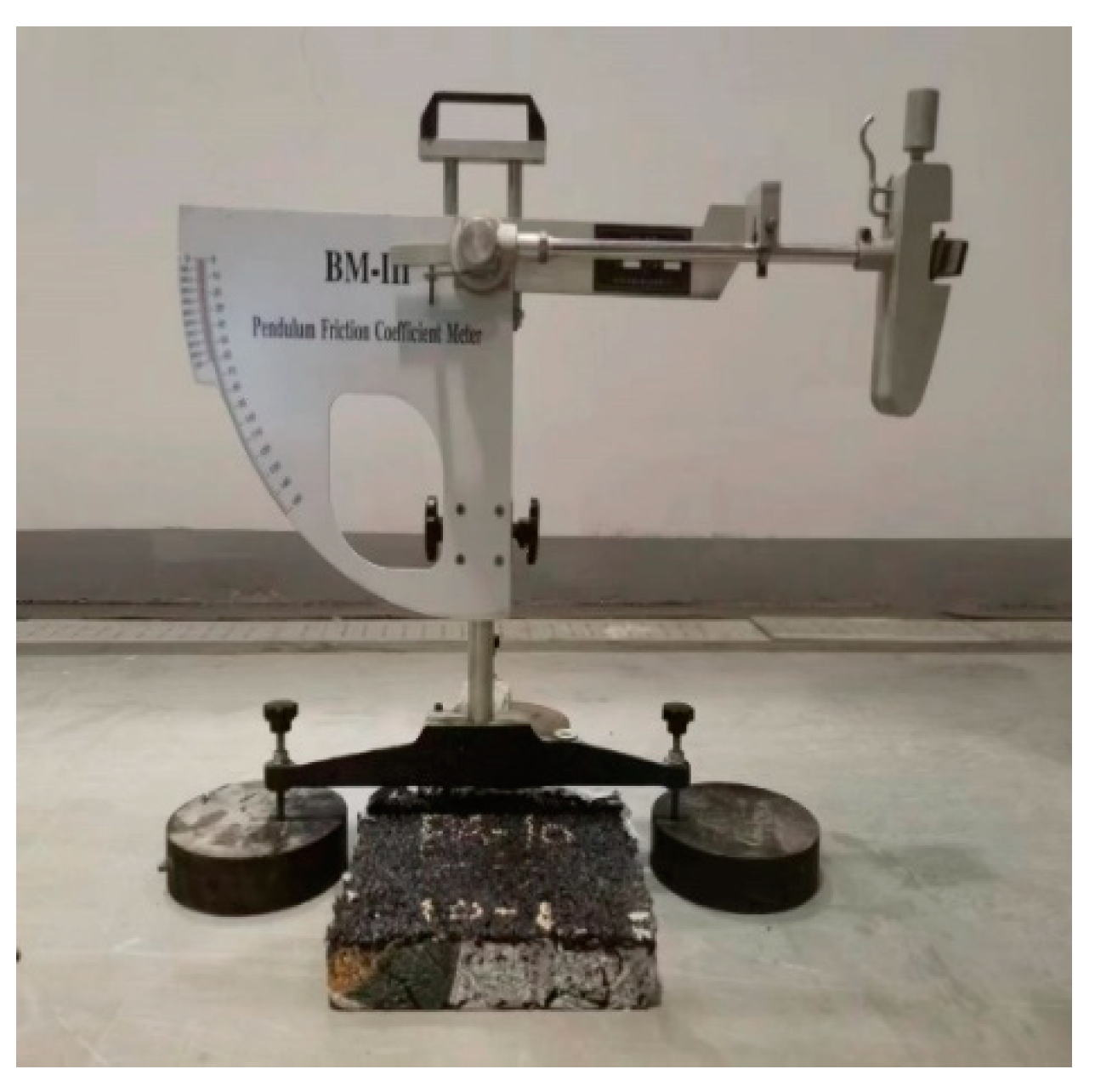
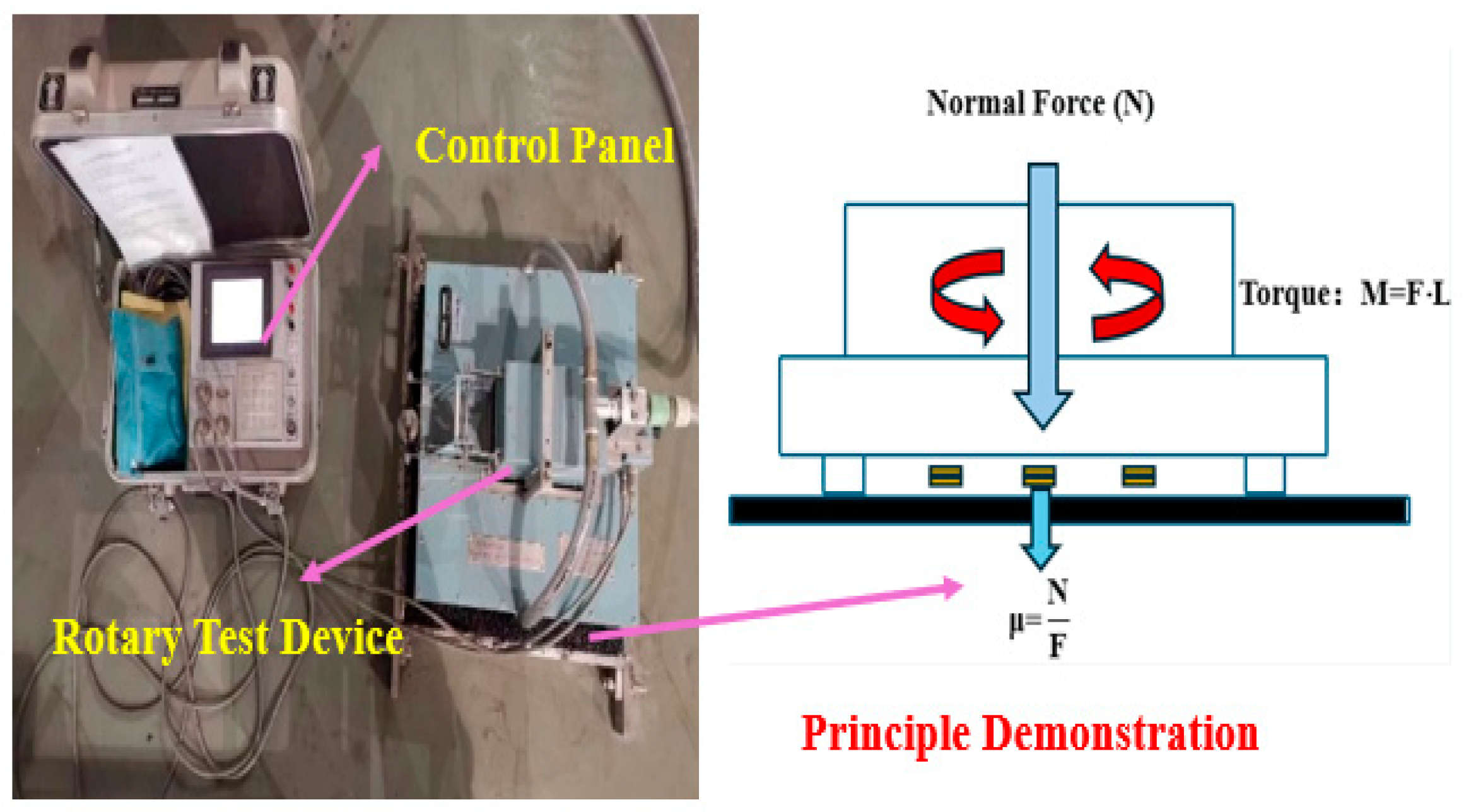
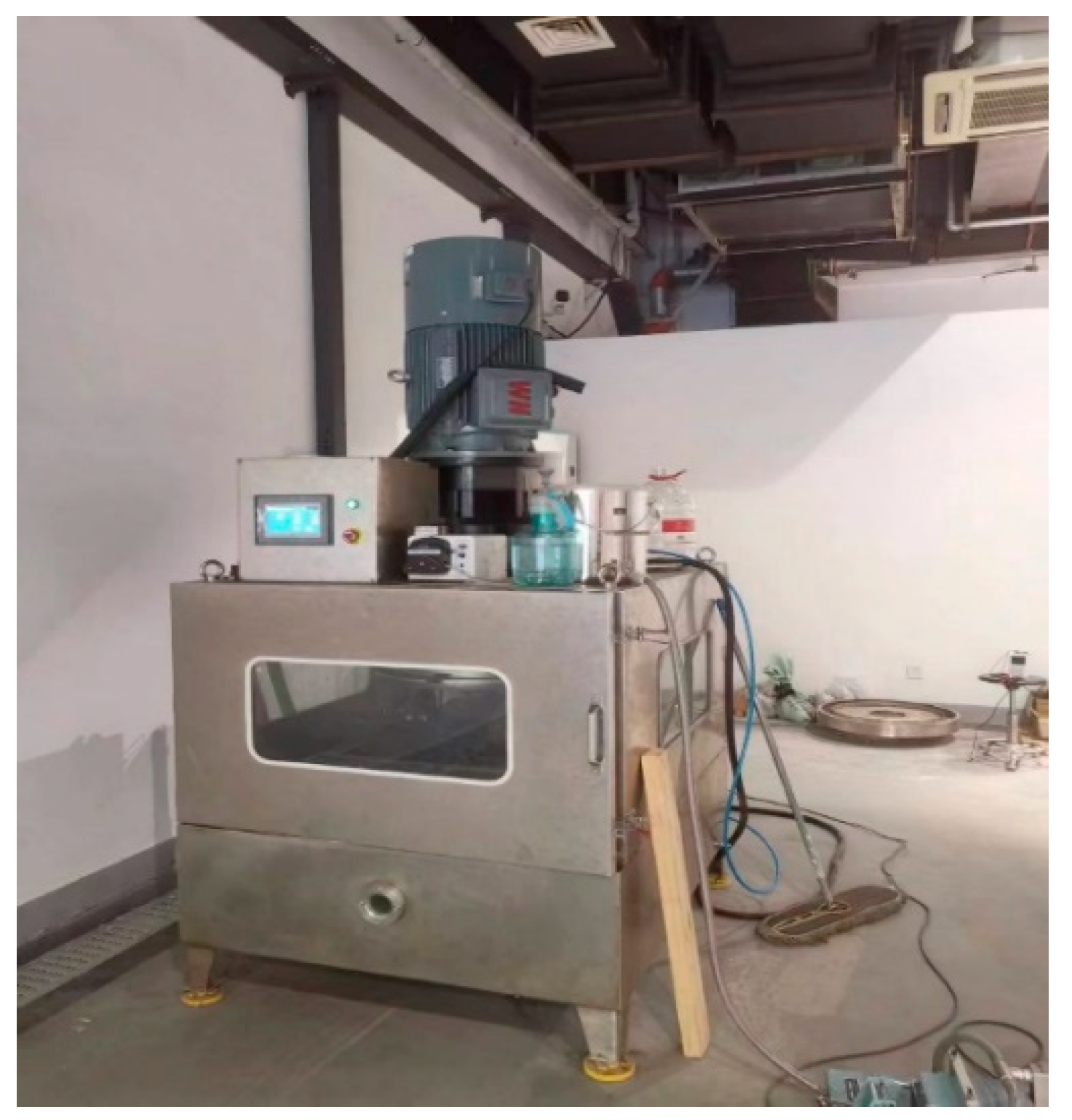
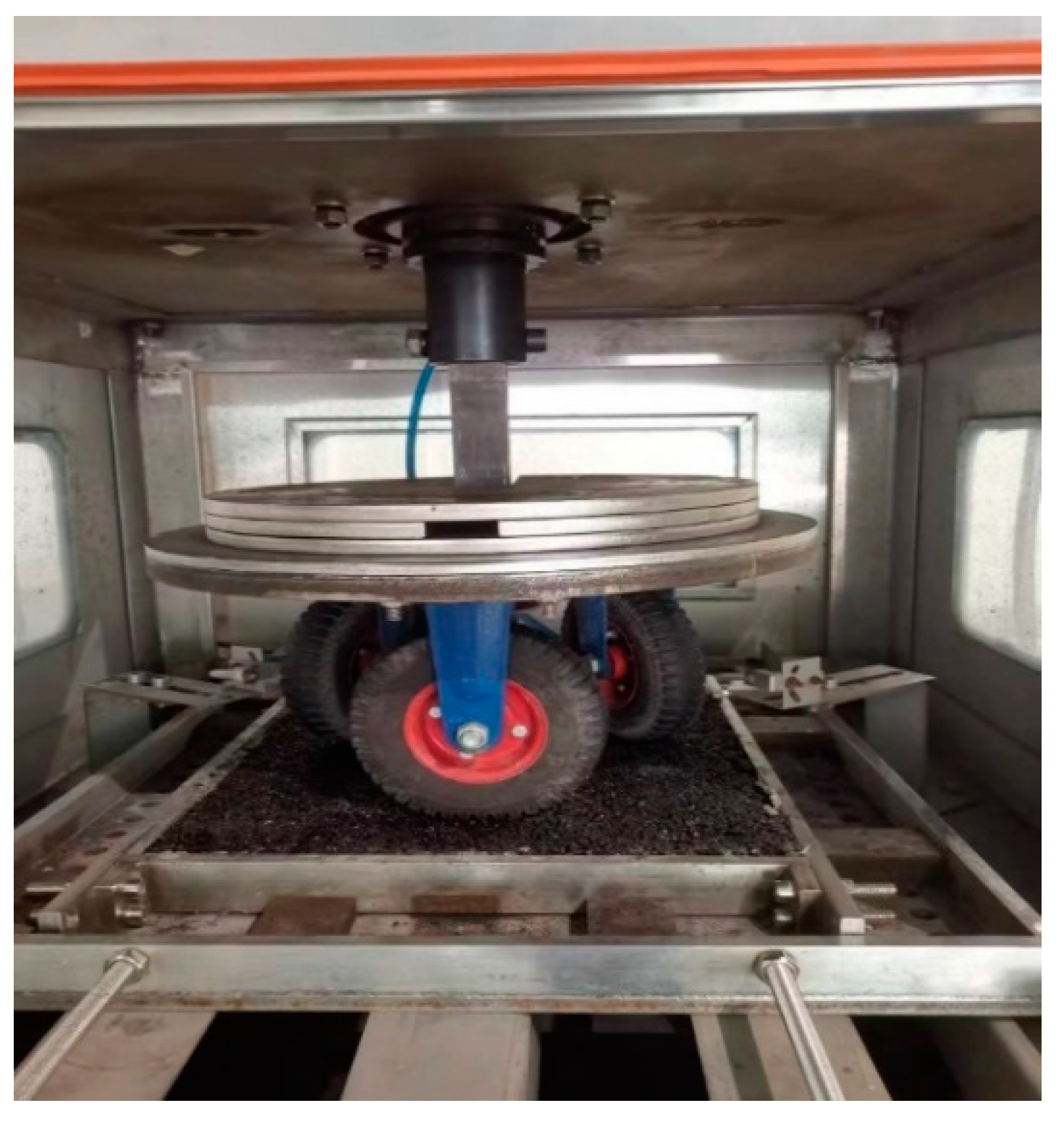
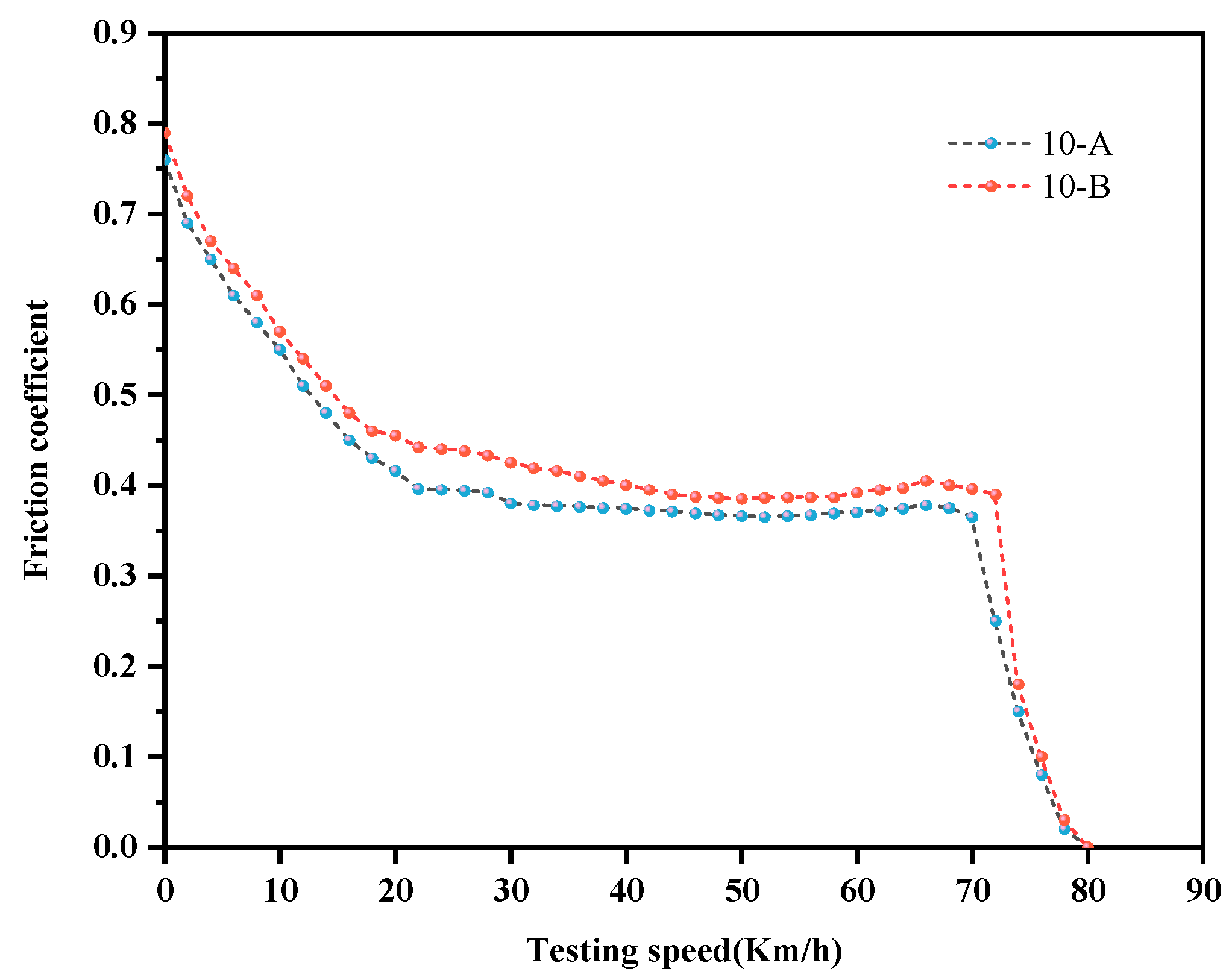
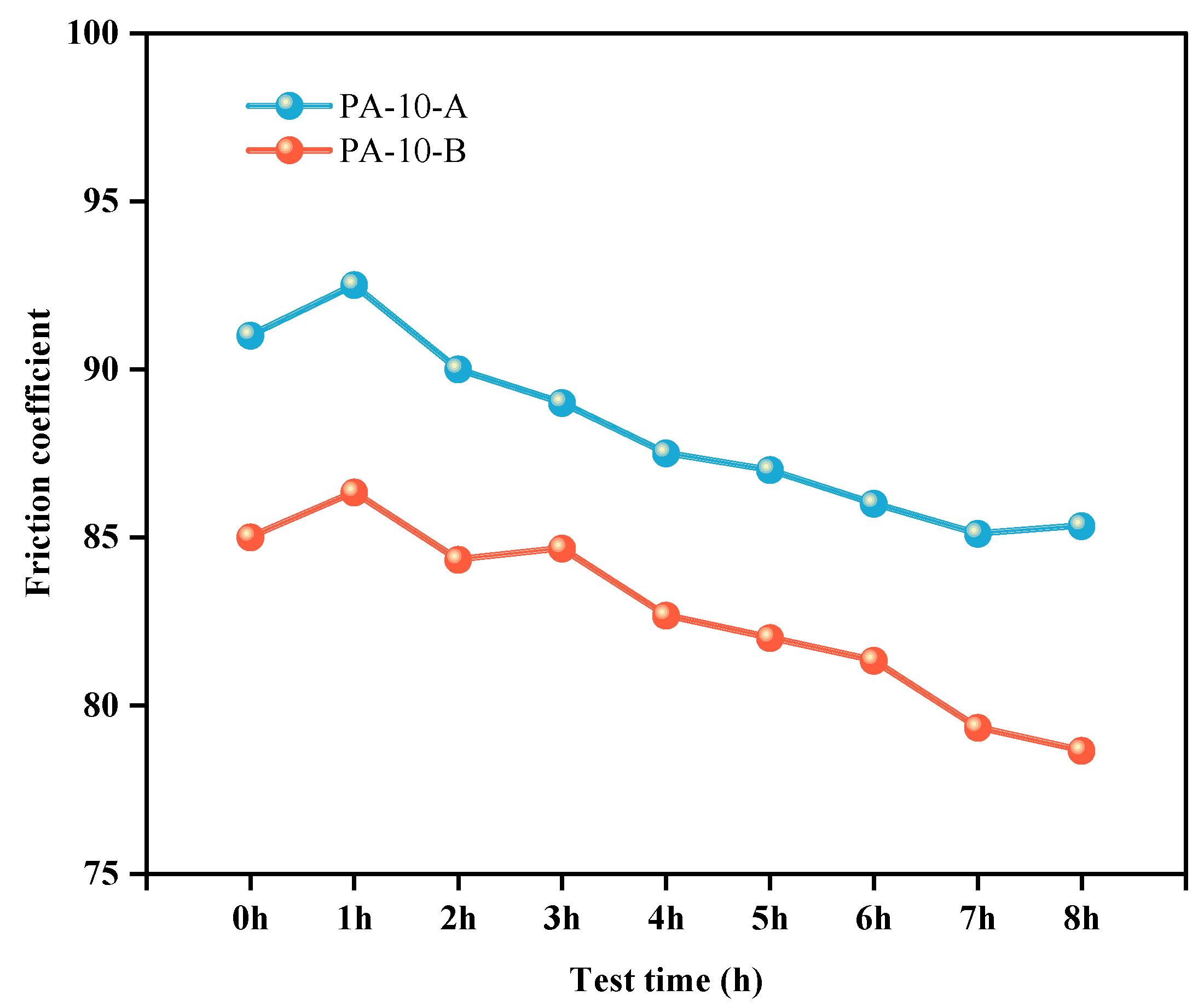

| Raw Material Ratios (%) | SBS | Resin | Antioxidant | Stabilizer | Co-Solvent |
|---|---|---|---|---|---|
| High viscosity modifier A | 54.9 | 25.1 | 0.9 | 0.7 | 18.4 |
| High viscosity modifier B | 61.4 | 21.2 | 0.4 | 1.2 | 15.8 |
| Items | Unit | Test Values | Specification |
|---|---|---|---|
| Penetratio | 25 °C, 0.1 mm | 59.3 | 40–60 |
| Ductility | 5 °C, cm | 28 | ≥20 |
| Softening point | °C | 83 | ≥60 |
| Solubility | % | 99.92 | ≥99 |
| Flash point | °C | 310 | ≥230 |
| Items | Unit | 0–3 mm | 3–5 mm | 5–10 mm | Specification |
|---|---|---|---|---|---|
| Apparent relative density | g/cm3 | 2.714 | 2.725 | 2.730 | ≥2.6 |
| Bulk density | g/cm3 | 2.591 | 2.707 | 2.684 | ≥2.6 |
| Water absorption | % | 0.63 | 0.5 | 0.5 | ≤2.0 |
| Crush value | % | - | - | 14 | ≤26 |
| Abrasion value | % | - | - | 16 | ≤28 |
| Items | Unit | Test Values | Specification |
|---|---|---|---|
| Apparent relative density | t/m3 | 2.796 | ≥2.50 |
| Water content | % | 0.1 | ≤1 |
| Appearance | - | No agglomerates | No agglomerates |
| Hydrophilic coefficient | - | 0.47 | <1 |
| Plasticity index | % | 2.1 | <1 |
| Items | Pendulum Friction Coefficient Experiment Results |
|---|---|
| 10 A | 79 |
| 10 B | 90 |
Disclaimer/Publisher’s Note: The statements, opinions and data contained in all publications are solely those of the individual author(s) and contributor(s) and not of MDPI and/or the editor(s). MDPI and/or the editor(s) disclaim responsibility for any injury to people or property resulting from any ideas, methods, instructions or products referred to in the content. |
© 2025 by the authors. Licensee MDPI, Basel, Switzerland. This article is an open access article distributed under the terms and conditions of the Creative Commons Attribution (CC BY) license (https://creativecommons.org/licenses/by/4.0/).
Share and Cite
Chen, W.; Zhang, Z.; Wei, J.; Zhang, X.; Gan, C.; Wang, W.; Sun, Y. Research on Mechanical Performance of Porous Asphalt Mixture with High-Viscosity Modified Asphalt. Appl. Sci. 2025, 15, 3631. https://doi.org/10.3390/app15073631
Chen W, Zhang Z, Wei J, Zhang X, Gan C, Wang W, Sun Y. Research on Mechanical Performance of Porous Asphalt Mixture with High-Viscosity Modified Asphalt. Applied Sciences. 2025; 15(7):3631. https://doi.org/10.3390/app15073631
Chicago/Turabian StyleChen, Wei, Zhengchao Zhang, Jincheng Wei, Xiaomeng Zhang, Chenghua Gan, Wenjian Wang, and Yuxuan Sun. 2025. "Research on Mechanical Performance of Porous Asphalt Mixture with High-Viscosity Modified Asphalt" Applied Sciences 15, no. 7: 3631. https://doi.org/10.3390/app15073631
APA StyleChen, W., Zhang, Z., Wei, J., Zhang, X., Gan, C., Wang, W., & Sun, Y. (2025). Research on Mechanical Performance of Porous Asphalt Mixture with High-Viscosity Modified Asphalt. Applied Sciences, 15(7), 3631. https://doi.org/10.3390/app15073631





